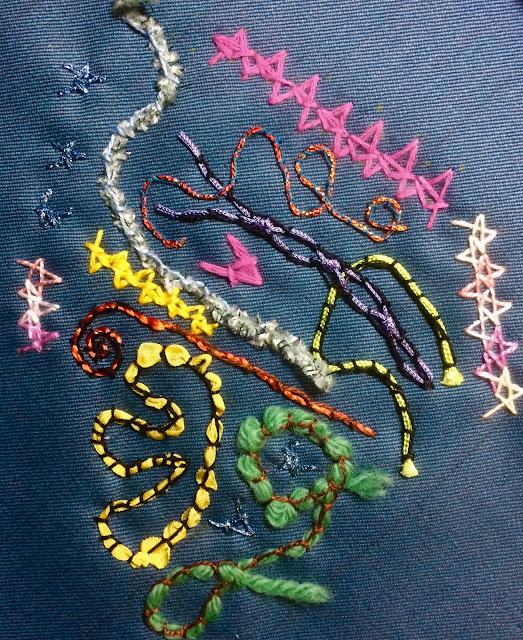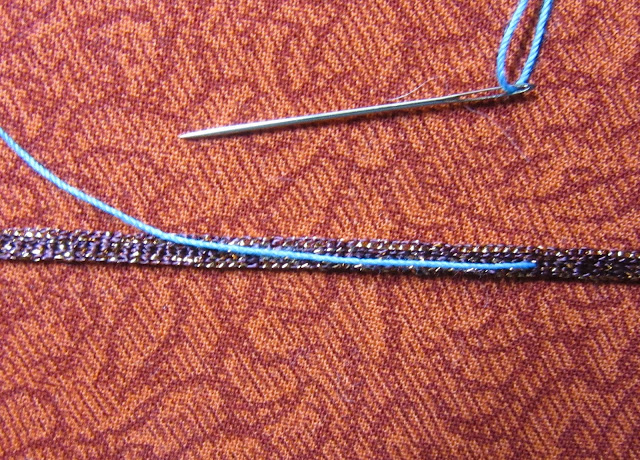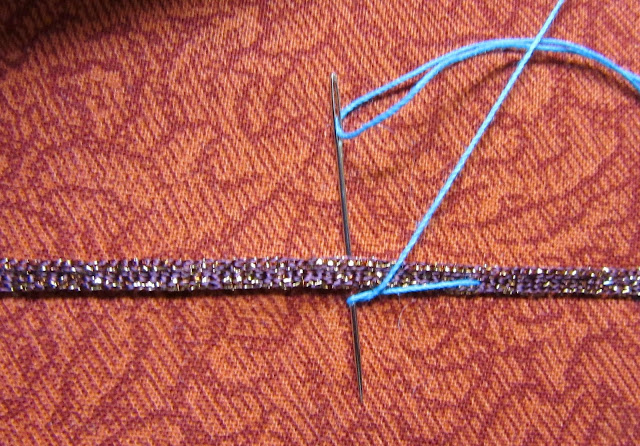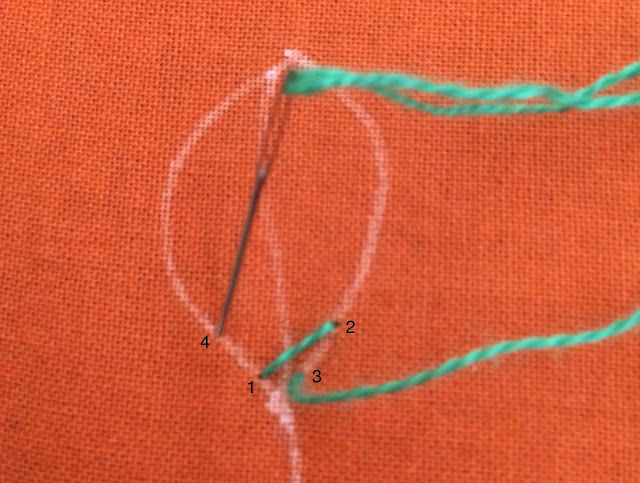Here is the last report of Work In Progress Wednesday of 2017.
Mola
I have concentrated work of the upper left corner.
Next up is the right hand side, but that is for next year.
Mola - Snippets of Interest
The Kuna was a nomad tribe, so instead of building monuments or making sculptures, their art work was to decorate themselves with body paint, and later, by wearing Mola blouses.
(Source: San Blas Islands official website)
Wishing you all enjoyment in the last few days of this year.
Wednesday, 27 December 2017
Monday, 25 December 2017
Merry Christmas
I got inspired by Mary Corbet's small Christmas tree embroideries and decided to use some stitches from my collection to make two cards.
The fir tree on the blue card is made up of Beaded Alternating Feather (TAST #155).
The starry tree on the red card has a trunk of Corded Coral (SSS #46) and branches of Thorn Stitch (SSS #41).
Wishing you a wonderful Christmas and Boxing Day.
Friday, 22 December 2017
Friday Homework for Lesson 47: Two-sided Insertion Stitch
Here is the last homework of the year for Sunday Stitch School.
I added Two-sided Insertion Stitch to the Corded Coral Stitches.
This stitch is SO much better when worked on Aida or even weave.
I added Two-sided Insertion Stitch to the Corded Coral Stitches.
This stitch is SO much better when worked on Aida or even weave.
With these stars I wish you Happy Holidays.
See you again on the other side of 2018.
Wednesday, 20 December 2017
WIPW - Thorn stitch? Thorn needle!
Work In Progress Wednesday
Mola
I have dug up a bit more colour from under the black top.
(Sorry about the blurred photo; too late in the day to take a decent photo.)
Mola - Snippets of Interest
The Kuna indians used hand made needles made from the long thorns of the Sinyu tree.
(Source: Rita Smith Mola Art)
Mola
I have dug up a bit more colour from under the black top.
(Sorry about the blurred photo; too late in the day to take a decent photo.)
Mola - Snippets of Interest
The Kuna indians used hand made needles made from the long thorns of the Sinyu tree.
(Source: Rita Smith Mola Art)
Sunday, 17 December 2017
Sunday Stitch School Lesson 47: Two-sided Insertion Stitch
Welcome to the last Sunday Stitch School lesson of the year. There is homework on Friday, but after that we'll take a break of two weeks over the winter holiday.
What stitch would be better to celebrate December with than one that is shaped like a star?
Stitch #47 is called Two-sided Insertion Stitch and was found in Reader's Digest's Complete Book of Embroidery. Why it is not called Star Stitch I do not know!
In Dutch it is called: Tweezijdige Steek. Thank you, Annet.
In French: entre-deux à double face (Thérèse de Dillmont)
- point d'entre-deux réversible (Mary Thomas) Thank you, Mattia
To work it you need some dots to lead your way:


On paper the design looks like this. If you are working on plain cloth, mark the pattern with a pen.

Making a template like this by piercing holes in a sheet of plastic is a good idea if you want to make a long line of even stitches. You can then easily poke the tip of a pencil through the holes and mark the pattern on any fabric.
Or work it on Aida or even weave, then you can count and find the right holes without problems, see my Aida sampler:
The reason it is called Two-sided Insertion Stitch is that it makes a very neat pattern on the back.
Stitch it in this order:
A›B›C›D›C›E›B›F›D›E›D›G (placed on the same level as D but to the right) ›F, and so on....
Follow these pictures:




A›B›C›D›C›E›B›F›D›E›D›G›F, and so on....

If you need a rhythm, look how the needle is facing: Towards you, away, away, away, towards you and then start over with Towards you.... Confusing?
On my SSS Reference chart:

Homework:
These Corded Coral stitches would like a sprinkling of stars, and maybe a band of stars, too.

What stitch would be better to celebrate December with than one that is shaped like a star?
Stitch #47 is called Two-sided Insertion Stitch and was found in Reader's Digest's Complete Book of Embroidery. Why it is not called Star Stitch I do not know!
In Dutch it is called: Tweezijdige Steek. Thank you, Annet.
In French: entre-deux à double face (Thérèse de Dillmont)
- point d'entre-deux réversible (Mary Thomas) Thank you, Mattia
To work it you need some dots to lead your way:


On paper the design looks like this. If you are working on plain cloth, mark the pattern with a pen.

Making a template like this by piercing holes in a sheet of plastic is a good idea if you want to make a long line of even stitches. You can then easily poke the tip of a pencil through the holes and mark the pattern on any fabric.
Or work it on Aida or even weave, then you can count and find the right holes without problems, see my Aida sampler:
The reason it is called Two-sided Insertion Stitch is that it makes a very neat pattern on the back.
Stitch it in this order:
A›B›C›D›C›E›B›F›D›E›D›G (placed on the same level as D but to the right) ›F, and so on....
Follow these pictures:




A›B›C›D›C›E›B›F›D›E›D›G›F, and so on....

If you need a rhythm, look how the needle is facing: Towards you, away, away, away, towards you and then start over with Towards you.... Confusing?
On my SSS Reference chart:

Homework:
These Corded Coral stitches would like a sprinkling of stars, and maybe a band of stars, too.

Friday, 15 December 2017
Friday Homework for Lesson 46: Corded Coral Stitch
Coral Stitch is easy, and so is this corded version.
With the Corded Coral Stitch you can really play around with unusual or difficult threads, braids or yarn as the base thread.
On a narrow braid or thin thread the Coral couching is not so obvious, but on a wide ribbon, like the yellow one in the picture, there is a funny 'trussed-up-ham' look.

On my Aida sampler I got very even stitches but they could be mistaken for Buttonhole Couching.
Sunday Stitch School Reference Chart
With the Corded Coral Stitch you can really play around with unusual or difficult threads, braids or yarn as the base thread.
On a narrow braid or thin thread the Coral couching is not so obvious, but on a wide ribbon, like the yellow one in the picture, there is a funny 'trussed-up-ham' look.

On my Aida sampler I got very even stitches but they could be mistaken for Buttonhole Couching.
Wednesday, 13 December 2017
WIPW - Mushroom
For Work In Progress Wednesday on my
Mola
I added a mushroom in the blank area (bottom left). There is more work to do in that corner as the mushroom is not very colourful.
Mola - Snippets of Interest
For some Mola eye candy, have a look at Fumiko Nakayama's blog.
Anyone visiting the Tokyo International Great Quilt Festival 2018 in Tokyo Dome, 25th -31st January, can see Ms Nakayama's entire collection in a special exhibition.
Read more about the rest of the show here.
Mola
I added a mushroom in the blank area (bottom left). There is more work to do in that corner as the mushroom is not very colourful.
Mola - Snippets of Interest
For some Mola eye candy, have a look at Fumiko Nakayama's blog.
Anyone visiting the Tokyo International Great Quilt Festival 2018 in Tokyo Dome, 25th -31st January, can see Ms Nakayama's entire collection in a special exhibition.
Read more about the rest of the show here.
Monday, 11 December 2017
Sunday Stitch School: Lesson 46 - Corded Coral Stitch
Although we are approaching Winter vacations, Christmas and New Year, here at Sunday Stitch School we will continue studying and add a few more stitches before the end of the year.
Stitch #46 is the corded version of a TAST stitch, Coral Stitch
and it is, of course, called: Corded Coral Stitch. 'Korallstygn med läggsöm' ought to be an appropriate name in Swedish.
Work it like this:
Place a thread, or in this case a braid, on the fabric. Keep the tension tight.
Let the working thread come up, on or at least near, the base thread.
Take a bite of the fabric, place the working thread on top and then under the needle.
Pull through and you have your first little knot.
Go on in the same way.
This is what it looks like when the corded thread is the same type as the working thread.
Homework:
Work the Aida sampler.
Try out the stitch with various threads.
Stitch #46 is the corded version of a TAST stitch, Coral Stitch
and it is, of course, called: Corded Coral Stitch. 'Korallstygn med läggsöm' ought to be an appropriate name in Swedish.
Work it like this:
Place a thread, or in this case a braid, on the fabric. Keep the tension tight.
Let the working thread come up, on or at least near, the base thread.
Take a bite of the fabric, place the working thread on top and then under the needle.
Pull through and you have your first little knot.
Go on in the same way.
This is what it looks like when the corded thread is the same type as the working thread.
Homework:
Work the Aida sampler.
Try out the stitch with various threads.
Friday, 8 December 2017
Friday Revision Homework - Stitches 41 - 45
We have learned 45 stitches so far here at Sunday Stitch School. Today's homework shows the last five stitches in a Sunbonnet Sue sampler.
Like many little girls Sue dreamed of becoming a ballerina. For many years she practiced hard at the barré, did her pliés, forced her feet into toe shoes, stood en pointe, pirouetted and leapt across the stage in a grand jeté.
(Check out the lingo here).
At 15, Sue the prima ballerina, retired, behind an armful of flowers. Time to move on to other interests!
Like many little girls Sue dreamed of becoming a ballerina. For many years she practiced hard at the barré, did her pliés, forced her feet into toe shoes, stood en pointe, pirouetted and leapt across the stage in a grand jeté.
(Check out the lingo here).
At 15, Sue the prima ballerina, retired, behind an armful of flowers. Time to move on to other interests!
Wednesday, 6 December 2017
WIPW - A Bit More Colour
Work In Progress Wednesday.
Mola
I have made a few more slits (lower left) and filled them with various coloured pieces of fabric, needle turned, and am now wondering what to do with the empty space to the left.
Mola - Snippets of Interest
The Cuna Indians inhabit 49 of the approximately 365 small islands in the San Blas Archipelago, Panama. The islands are off the hurricane path, but are at risk from sea level rise, and might be uninhabitable in the late 21st century.
(Source: Wikipedia)
Mola
I have made a few more slits (lower left) and filled them with various coloured pieces of fabric, needle turned, and am now wondering what to do with the empty space to the left.
Mola - Snippets of Interest
The Cuna Indians inhabit 49 of the approximately 365 small islands in the San Blas Archipelago, Panama. The islands are off the hurricane path, but are at risk from sea level rise, and might be uninhabitable in the late 21st century.
(Source: Wikipedia)
Sunday, 3 December 2017
Sunday Stitch School - Revision: Stitches 41 - 45
Sunday Stitch School has been running for more than a year now. 45 stitches have been learned so far.
Once again it is time for another revision lesson to sum up the last five stitches, which have all been related to plants.
Click on the headline to see instructions and homework.
41 Thorn Stitch
Easy and quick, it adds a lot of 'spike' to a line.
42 Rambling Rose Stitch
It is just as lovely as a real rambling rose. This stitch, too, is quick and easy.
43 Moss Stitch
The moss stitch is named well, some species of moss really look like this!
Making the knotty part is a bit fiddly, but it is worth it as the knot stands out so well in the middle.
Work it in black and you have an insect instead.
44 Mille Fleur
Lazy Daisy, Lazy Diasy, Lazy Daisy.... give me your needle do, (and some thread, too) I'm half crazy all for the love of you....
It IS a lovely stitch, it WON'T drive you crazy, not even half crazy. Instead when used in a circle you have a nice flower.
What's more, you don't need to stitch while on a bicycle built for two!
(Lyrics)
45 Leaf Stitch
If you make a flower, you will most likely need a leaf, too. Here is a nice one.
Homework:
Friday, 1 December 2017
Friday Homework for Lesson 45: Leaf Stitch
Wednesday, 29 November 2017
WIPW - Spot the Difference
10 points if you can spot the difference! Not much progress for Work In Progress Wednesday.
Mola
Last Wednesday
Today, Wednesday
No need to comment!
Mola - Snippets of Interest
Another name for mola (the blouse worn by Cuna Indian women) is dulemor.
(Source: Wikipedia)
Mola
Last Wednesday
Today, Wednesday
No need to comment!
Mola - Snippets of Interest
Another name for mola (the blouse worn by Cuna Indian women) is dulemor.
(Source: Wikipedia)
Tuesday, 28 November 2017
TAST 155: Beaded Alternating Feather Stitch
TAST stands for Take A Stitch Tuesday which is an online course of stitches on Sharon Boggon's Pintangle. Join in and learn. If you want to do it from scratch, there will be a rerun starting next year.
Read more about TAST here.
Learn how to stitch the Beaded Alternating Feather Stitch here.
As I have explained before, I want all the TAST stitches in one (private) collection and will give them the chronological number in the order I learn them.
So now it is time for Beaded Alternating Feather Stitch, which I will call TAST #155.
(The green seam on the left is upside down. )
On the TAST Reference Chart.
Read more about TAST here.
Learn how to stitch the Beaded Alternating Feather Stitch here.
As I have explained before, I want all the TAST stitches in one (private) collection and will give them the chronological number in the order I learn them.
So now it is time for Beaded Alternating Feather Stitch, which I will call TAST #155.
(The green seam on the left is upside down. )
On the TAST Reference Chart.
Sunday, 26 November 2017
Sunday Stitch School: Lesson 45 - Leaf Stitch
We have stepped on soft Moss, pricked ourselves on Thorns, breathed in the fragrance of Thousand Flowers and Rambling Roses. What else can we do in the garden? Kick Leaves, of course!
Today's stitch at Sunday Stitch School is Leaf Stitch.
Although I have seen several instructions in books, the best one is over at Kimberly Quimet. Her photos are far better than mine, but I will add these anyway.
Mattia tells me the French name is, Point de Fueilla.
The Leaf Stitch is basically a cross worked in the order of 1-2-3-4, as shown below.
The next cross is started inside the first one.
After that you just go on.
This week you have a lot of
Homework:
1) add a row of leaves to the Aida sampler.
Today's stitch at Sunday Stitch School is Leaf Stitch.
Although I have seen several instructions in books, the best one is over at Kimberly Quimet. Her photos are far better than mine, but I will add these anyway.
Mattia tells me the French name is, Point de Fueilla.
The Leaf Stitch is basically a cross worked in the order of 1-2-3-4, as shown below.
After that you just go on.
Homework:
1) add a row of leaves to the Aida sampler.
2) a sprinkling of leaves on the Sunday Stitch School sampler, if you please,
and finally
3) brighten up this wet asphalt with some fallen leaves
Subscribe to:
Comments (Atom)











































